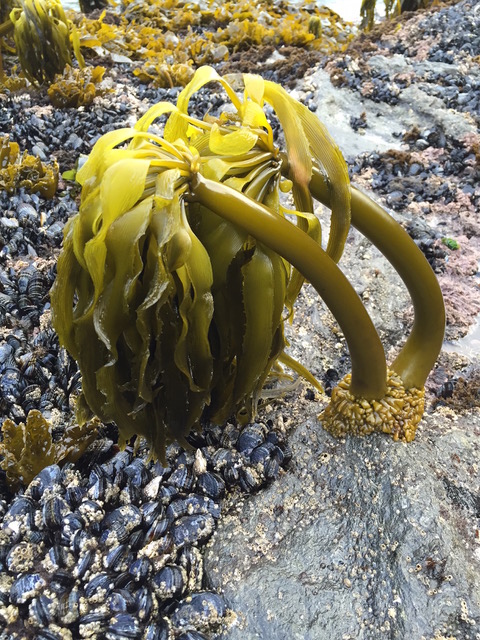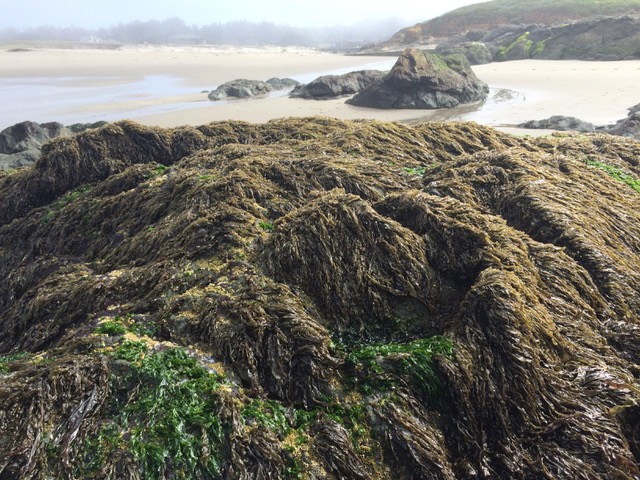I. Mendocino headlands, 6:20 a.m.
Muffled grey skies, finger-chilling breeze, salinity infusing nostrils and eyes. The rhythmic whoosh and sigh of waves engulfing, abandoning, then reclaiming landfall with the fervency of ambivalent lovers. We have one hour before the minus tide recovers a sister-world of beings left gasping in dry oxygen. My girlfriend Terry leads the way along gravelly path, nimbly stepping alongside scruffy cliff sides. She is outfitted in a wetsuit and booties, mesh bags slung over one shoulder, a sexy black selkie.
Winter waves off the Mendocino headlands. Video by Jeanine Pfeiffer
“Never turn your back on the ocean,” Terry reminds me.
“Never!” I affirm, fiercely concentrating on each slippery foothold.
Our Pacific ocean is anything but pacific. She is one hungry mother with waves that slap you silly and “whities,” Great White sharks the size of minivans who mistake divers and surfers for seals. If the waves or whities don’t get you, massive kelp jungles lie beneath the surface: disorienting, tangle-you-up-and-pin-you-down mazes on a good day.
Terry and I are harvesting sea palm, one of many edible seaweeds clinging to coastal rocks. Sea palms are spunky, lemony-olive-green creatures who survive constant exposure to air and grow heartily on stretches only partially wave-embraced. Stretches where mere humans can, and are, abducted by rogue waves in a single breath.
Holding on to tidal real estate demands tenacity. Currents surge, buffet, tug, displace. Intertidal residents are hyper-locavores, capturing food as it streams or swims by. For sessile algae like bull kelp and sea palm living within active surge zones, their territory is maintained via holdfasts or haptera: structures resembling a mash-up of a root and an anchor, or a finger and a claw.
II. If I were a poet composing odes to the ocean, my stanzas would bypass sparkling blue in favor of dull brown and green. Marine photosynthesizers – plankton, algae, and seaweed – are the megastars of the ocean, comprising the dietary base of food webs and sustaining grazers (turtles, fish with teeth), slurpers (sponges, whales), and munchers (sea urchins, crustaceans). Submerged algal colonies serve as oceanic supermarkets, condominiums, nurseries, oxygen pumps, and shock absorbers; aggregations of bull kelp are the oceanic equivalent of terrestrial rainforests.
Haptera make these ecosystems possible. They are unique to organisms colonizing wet, instable environs. Bull kelp boast the largest haptera, enabling these underwater giants to grow up to sixty centimeters per day, reach over thirteen stories tall, and rotate in place, accommodating the high torque of pelagic currents. Massive kelp habitats underscore our bays and coves, harvestable only by kayak. Bull kelp fronds are my favorite type of seaweed: delicate, translucent, and über-salty, melting on the tongue.
Yet during recent winters of overly warm waters, instead of resilient, rubber-bandy kelp shoots surging up from the ocean floor and tangling in everyone’s flippers, emergent kelp haptera turned soft, melting into mushy stumps. Tiny balls of kelp broke free, clumped into rafts, and floated away. Remaining stumps were weighed down by urchins and abalone clinging awkwardly to their tips, oversized clodhoppers consuming their home base. Up and down our coast the kelp beds went eerily absent. Our ocean lost its green and brown, reverted back to blue.
III. The sea palm, a delicate half-cousin of bull kelp, is around the size of a ping-pong paddle. The palm’s holdfast is a tight bundle of nubby tubes with a slender stem (“stipe”) supporting a bouffant of curvy fronds (“blades”). Despite resembling a tiny, squat palm, the sea palm is not a palm. It is not a plant. It is not a seaweed, or an algae. Although it photosynthesizes with chloroplasts and has alginate cell walls, the sea palm is a chromist with different chlorophyll pigments from its closest botanical relatives.

At the height of our scientific dichotomizing, before we discovered extremophiles thriving on sulfuric fumes at the base of profundal ocean vents, we divided Life into Prokaryotes (gooey cytoplasmic somethings with no nucleus or organelles) versus Eukaryotes (everything else), while defining all life as oxygen-dependent. Old-fashioned Trees of Life further segregated eukaryotes into separate kingdoms: Animalia, Plantae, and Fungi. Because most algae are phototrophic (solar-energy food producers), initially we grouped them with the plants, employing simple labels of “brown,” “green,” or “red” algae.
No longer.
When we examined algal lifeforms with the minute attention they deserved, they defied straightforward categorizations: proving to be sexual or asexual, unicellular or multicellular, phototrophic or mixotrophic. Confused biologists invented an entirely new eukaryotic kingdom – Protista – and stuck algae into it, along with slime molds, amoebas, diatoms, and assundry and unpronounceables.
Nevertheless, the Protista kingdom of biology textbooks remains a hotly contested grab bag for organisms representing evolutionary conundrums; i.e., who descended from whom? Whenever we revise the Tree of Life, scientific databases worldwide suffer minor cladistic implosions: definitions are thrown out, new labels printed, and terms we once pronounced with authoritative glee must be unremembered, replaced with foreign ones we resist for their strange mouthfeel, their potential transience. Each semester my lectures cover terms that didn’t exist when I studied plant physiology in graduate school, novelties requiring me to deny what I thought I knew.
Now I teach my students that sea palm (possibly? probably?) belongs to the Protista and the Chromista and the Chromalveoata Kingdoms. The lowly sea palm remains one of those weird, otherwise unclassifiable eukaryotes, its identity and origins obscure. Subject to change.
IV. For half a millennium, while Pacific coastal peoples fermented seaweed delicacies, crafted ingenious kelp traps to gather herring spawn, and exported dried seaweed to treat goiter in distant tribes, English speakers used the word “seaweed” to describe anything and everything looking like a plant growing in the sea. A seaweed was a seaweed was a seaweed, from the Old English sæwar, the Middle English see + wede, or the Old Saxon sǣ + wiod.

V. On another minus-tide day, my friend Misty and I skirted around rocky outcroppings on a county beach more frequently visited by narrow-billed seabirds than humans. We shucked off our sneakers, rolled up our pants, and climbed over boulders in the surf, tugging and tucking handfuls of nori into washable totes, gathering enough to share with elders because nori, known as “sea leaf” (mei bil) in the tongue of Kashaya Pomo, is the favorite of tribal aunties and uncles. Dried seaweed, when lightly fried, makes a crunchy snack: a healthier substitute for naughty potato chips, to which I am otherwise addicted.
Wild nori (as opposed to the plastic-encased, industrially processed, and nutritionally poor wafers I used to think of as seaweed) is kinked and crinkled, rubber-chewy with an intense marine taste. Young nori shines in kelly-green hues, morphs into a deep hunter shade when mature, or turns black-chocolate when sunburnt. Harvested nori dries into night-green, the hue of murky benthos. The best nori for collecting are the young strands: silky and diaphanous, lightly tensile.
Before we began collecting nori, Misty taught me a seaweed song. She made it up: like many of my Native friends, she is patchworking her heritage. Songs that should have descended from family members are culled from people in other tribes, from the few elders who held onto their memories and stayed alive long enough to teach others. Elders who survived boarding schools where singing their songs earned a glare, a shush, a slap—or worse—from those who claimed to know better.
Misty’s seaweed song can be heard is recorded and co-sung by Jeanine Pfeiffer
VI. First Nations consider the entire Pacific coastline as their ancestral territory. Countless tribal bands historically relied on, and continue to use, hundreds of culturally significant marine species. To avoid inter-tribal conflict, harvesting rights were defined geographically, spatially, seasonally, or temporally: divided by a span of beach or waterway, by one side or another of an outcropping or cove, by moon phases, by different times of day, or by tidal regimes. Contemporary tribes still adhere to cultural taboos such as not picking seaweed when it’s raining, only harvesting from traditionally demarcated areas, and never taking pregnant females or alpha males.
Done correctly, wild food harvesting can help restore ecological balance where habitats have been destroyed or interspecies relationships distorted. An infamous example lies northwest of the Mendocino headlands, within a marine reserve where urchin diving was, and still is, prohibited. Eliminating human harvesting resulted in devastation: portions of the reserve turned into an underwater desert when urchin populations exploded and ate everything in sight, as their natural predators, sea otters and sheephead fish, were driven to extinction generations earlier. Unchecked urchins—flexible omnivores with rasping teeth—happily consume algae, kelp, shellfish, sponges, starfish, jellyfish, and barnacles, even fellow urchins.
Local fishermen repeatedly presented testimony about conditions in the urchin-infested reserve during policy meetings, while tribal representatives fought to retain their ancestral harvesting rights. Panelists listened half-heartedly, texting beneath the dais, discounting the speakers. Exasperated with continued scientific denial, Tom, an old-timer with over thirty thousand hours of urchin diving experience, bought an underwater camera, shot footage of the urchin barren, and presented it at the next meeting. Agency personnel finally sat up and took notice, a few agreeing to take a tour on Tom’s boat.
Six years later, a new program pays divers to remove tons of sea urchins from the vicinity, by any means necessary.
Red sea urchin barren filmed by the California Department of Fish and Game, 2008.
The urchin removal is helpful: with bull kelp gone from most of the coastline, there aren’t enough pickings for divers seeking commercially viable red urchins. Reds once dominated the surf zone, while purple urchins aggregated in deeper waters. In just four years, the two species switched behaviors and habitats: reds shifted out to the ten-to-twenty meter zone, while purples extended their range into the nearshore, in feeding lines the reds will not approach. Purple populations – a hardier, leaner species obtaining its nutrients from water if no food is available – exploded to almost one hundred times their normal range. Commercial divers who persisted in harvesting reds were hit hard by decompression sickness (“the bends”) after diving deeper and more frequently without sufficient recovery time. Red urchin populations continued to shrink, while their uni yield was compromised by “empty shells,” urchins with no gonads left, or “water urchins” that look good when harvesting but fall apart during processing.
With too few reds and too many purples, urchin processing plants, the largest employers remaining in Ft. Bragg after wild salmon and tuna populations tanked, slowed and sputtered to a halt. Divers, wholesalers, and side businesses (kayak rentals, whale and fishing tours, retail seafood outlets, bars and restaurants) subsequently disappeared from Mendocino county’s only commercially viable harbor. When Tom’s family finally gave up and moved their fleet to Alaska, they shut down their urchin processing plant, closed their watersports store, and turned their pumps off, eliminating the only dockside fueling station for two hundred kilometers of coastline. We don’t know if they will ever come back.
VII. Urchins are the main ecological competitors of California’s priciest, most highly regulated, and most intensively poached native species: abalone. Of seven abalone species found in California waters, two are federally endangered (the black and the white), two are on the watch list (the green and the pink), two (pinto and flat) are considered too small to collect for food, and only one species, the red abalone – the largest abalone in the world – has maintained populations large enough to qualify as a fishery.
Following centuries of abalone abundance, demonstrated by massive middens left behind by tribes living along 1,350 kilometers of coastline, how did we lose so much in fifty years? The usual: greed, overharvesting, pollution, and belated regulatory action. And stupidity. We ignored all the warning signs. We waited too long to act.
After Chinese-American and Japanese-American offshore commerce in abalone crashed in the 1850s–1900s, the nascent California government set catch limits on abalone, but failed to track which abalone populations they were trying to limit. Black? White? Green? Pink? Red?
This oversight—treating abalone as a single fishery—led to serial depletion, where declining numbers of one species were masked by abundance in another. Subsequent size regulations aimed at allowing abalone to achieve sexual maturity and spawn several times before they were fished relied on the presumption that abalone spawned like clockwork. Biological news flash: they don’t.
If abalone densities dip too low, chances for reliable hook-ups diminish; it’s like trying to run a successful dating app in a remote, underpopulated market. Bull kelp suffers a related fate: if populations become too small and isolated, they won’t produce enough spores to establish larger patches. Even in a perfect hook-up world, most marine spawn don’t survive—they become diseased or malnourished, fail to find secure spots to land on and grow, are smothered by sand, or consumed by predators. How many survive? We have no idea.
VIII. When proximity to major urban populations in the San Francisco Bay area reduced red abalone along the coast in Marin and Sonoma counties, and red tide at Fort Ross shut down the most popular dive spot in the region, the diving effort shifted north to Mendocino county, the last and largest viable wild abalone fishery – until this year.
During the 2017–2018 winter and spring cycles, reports came in of dead and dying abalone washing up along the Sonoma and Mendocino county coasts. Underwater surveys found more dead abalone than live, with the remaining abalone scarcer, smaller, and sicker than ever measured. When abalone populations dipped below the minimal viable density of 0.30 abalone per square meter, Fish and Wildlife shut down the fishery for the indefinite future.
“This makes it really hard for elders,” commented my girlfriend Nicole (Coast Wailaki), when I announced the latest set of regulations on Facebook. Historically, her people rock-picked abalone early in the morning at low tide or minus tide. Rock-picking is a sustainable form of abalone fishing, because it protects deep-water abalone populations. The newest regulations made it impossible for any tribal person to engage in traditional harvesting without breaking the law.
Nicole’s people come from an astoundingly beautiful area, the “Lost Coast” south of the Mattole River where roads are nonexistent or impassible and the fishing is excellent. Nicole exists because her great-great-great aunt, renamed Sally Bell, escaped the 1830s Needle Rock Massacre where her family and tribal band were slaughtered by angry pioneers. Sally’s infant sister, renamed Ellen Sutherland, survived because a settler’s wife rescued the baby from the waves where she was crying and rolling around in a cradle basket.
I can picture it: the eerie horror-stink of slain bodies, the waters breaking on the shore, shushing back. A baby’s cries rising through the surf, a woman wading in, her long skirts growing heavy with saltwater. The woman is fierce in her protection of the infant. She clutches the baby to her chest, holds it tight in her arms. Because she doesn’t know what else to do.
IX. The Wailaki (or Wylakke or Wylac-kie), earlier misclassified by ethnographers as Lassik or Sinkyone, are currently misclassified as extinct, or by the name of another tribe whose federal identity card they now hold. The word “Wi-lak-ke” itself – roughly translating as “north language” – was acquired from a different set of unfamiliar peoples, the Wintun.
Before the genocides of the 1850–1870s, when Wailaki ancestors lived and loved over the mountainous, forested terrains hugging the Eel River as it stretched to the sea, the humans who belonged to those mountains and that river collectively called themselves the Keh-nes-te. Their names expressed intimacy with their landscape: the people of the Blue/White/Red Pestle Rock or the Flint/Ochre/Step-Over-Flow Creek. The Kaikiitce-Kaiyaah, the Live Oak People. The Nee’taash-Kaiyaah, the Landslide People.
The last fluent speakers of Wailaki walked on sometime in the 1960s. Their descendants, with the help of linguists, graduate students, and texts of ethnographic interviews from the 1920s with child survivors of tribal massacres, are laboriously assembling Wailaki dictionaries and curricula, guessing at how to pronounce words, inventing new terms from related languages.
X. When I volunteered as an ambulance driver in Mendocino county, our most bizarre middle-of-the-night call involved a stocky man wandering dazed and barefoot along the highway, clad only in a pair of dingy shorts. He didn’t know who he was or how to find his car – having crashed it several hours earlier – but he was adamant about making sure his unshelled (and therefore illegal) abalone accompanied him to the hospital. After the fire department and the sheriff’s deputy had their say, we coaxed the man onto a stretcher and laid the moist, inert, teeshirt-wrapped flesh onto his chest, where he held fast to it.
Given how long it took to process patients in the nearest emergency room, I predicted the abalone wouldn’t survive the night. But I said nothing, grimly shutting the ambulance doors before climbing into the driver’s seat. After the medic gave the signal I picked up the mic and radioed dispatch: “Transporting one, Code Two.”
Revving into first gear, I pulled the ambulance onto a moon-soaked roadway and switched on our emergency lights. Rotating yellow flashes echoed across the roadside, bearing witness during our slow drive up one hill and down the next to the county hospital. A one-way trip for the unnamed man and his dying beast; a silent release by a driver with salt-stung eyes.
—
Dr. Jeanine Pfeiffer is an ethnoecologist specializing in biocultural diversity conservation. Her award-winning nonfiction appears in Bellevue Literary Review, Camas, Citron Review, Flyway, Hippocampus, High Country News, Langscape, Medium, and Silver Needle Press. Her scientific works are archived on ResearchGate.net. More at jeaninepfeiffer.com.
